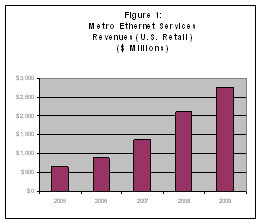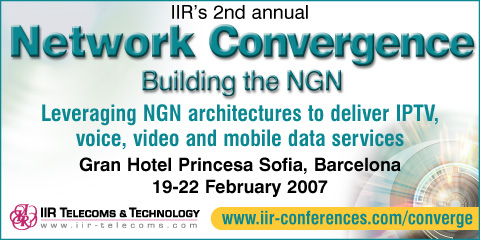|
|

article page | 1 | 2 |
A second reason that SLAs do not currently play a more important role in the choice of Ethernet service is the way in which end-users are employing it. As New Paradigm Resources Group describes in its forthcoming Metro Ethernet Report™, most Carrier Ethernet service today is used for relatively unsophisticated, point-to-point, dedicated transport. The consensus is that as end-users become more comfortable with Carrier Ethernet, it will be adopted for more complex, multi-point, integrated services including real-time services like voice and video, and for mission-critical applications. Under these conditions end-users will be more concerned with service quality and will demand rigorous SLAs.
In addition to routine SLA parameters like network availability and mean-time-to-repair (MTTR), more detailed transport quality parameters like latency, jitter and packet loss will be of great concern and will serve as “differentiators” for carrier products.
|
|
Rather than simply “more for less,” customers are discovering that Ethernet promises “several times more” if they’re willing to pay “a bit more.” |
|
Furthermore optical Carrier Ethernet access availability has been limited since only about 15% of office buildings in the US are fed by fiber. This still presents a quandary for risk-averse and cost-conscious IT managers. Their existing Frame Relay, ATM, and private line networks are stable, proven and have ubiquitous coverage.
Looking Forward
A technology development that addresses both the “bandwidth gap” between a T1 and standard 10 Mbps Ethernet and the limited availability of fiber to end user buildings is Ethernet over copper. This technology uses dry copper pairs for transport. It can provide “mid-band Ethernet” in the 2-8 Mbps range in
|
|
|
| |

Great Expectations…
Enthusiastic promoters of Carrier Ethernet have created some unfortunate expectations in the minds of end-users when it comes to price comparisons between emerging metro Ethernet services and traditional transport. with a 10 Mbps Ethernet circuit or a T3 circuit with a 100 Mbps Ethernet circuit, their cost per cir As a result, some end-users are predisposed to believe that if they replace, say, a T1 circuitcuit will be lower. In reality, of course, their cost per unit of bandwidth will decrease, but their cost per circuit will increase. Rather than simply “more for less,” customers are discovering that Ethernet promises “several times more” if they’re willing to pay “a bit more.”
Optical Carrier Ethernet offerings have typically had a minimum port speed of 10 Mbps. Thus, critics suggest, Ethernet’s value proposition to a standard T1 dedicated transport customer is “ten times the bandwidth at twice the cost per circuit.” For offices pushing the limits of a single T1, or even a couple T1s, the big leap in bandwidth would certainly be nice—but not at an extra cost.

|
|

configurations using multiple bonded copper pairs. This neatly satisfies the gap many end-users face. It also allows service providers to begin addressing the vast majority of customers who are not served by fiber, and do so at price-points that challenge customers’ existing T1 and DSL services.
The need to serve a sub-10 Mbps, enterprise Ethernet market may fade in importance however. The Metro Ethernet Report™ explores two current trends that are inexorably—but ever more quickly—overwhelming arguments about optical carrier Ethernet’s suitability. First, the proliferation of bandwidth-consuming applications—the voice, image, and video effect—is rapidly driving up end-user throughput requirements. Second, there is an interactive effect. The availability of bandwidth at a low per-unit cost does, in itself, stimulate applications that demand even greater bandwidth. The continued extension of fiber networks, at least to business locations, seems likely to accelerate and along with it Ethernet accessibility.
Carrier Ethernet can provide much more than just cheap, scaleable bandwidth. It supports advanced, virtual network services and integrates well with multiple applications to create high value services. We forecast that service revenues will approach $3 billion by 2009 (see Figure 1). Many of these services will be unique and differentiated, providing telecommunications operators many opportunities to compete. Future competition will not be the simple price competition that has characterized “me-too” services. Clever service providers will now have the tools to provide much more than just simple transport or traditional telecommunications offerings. The era ahead will be fun and exciting as creativity is unleashed.
|
|
|
|





